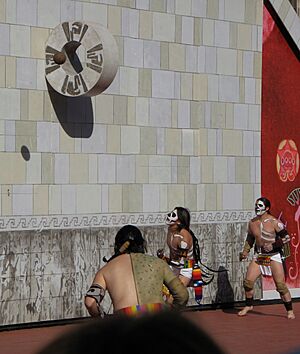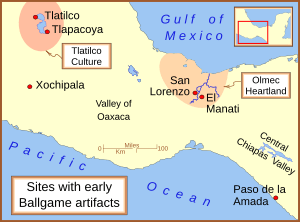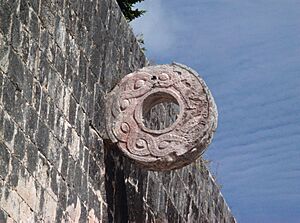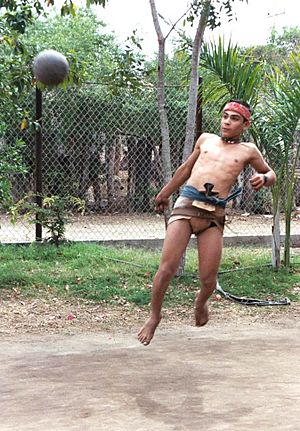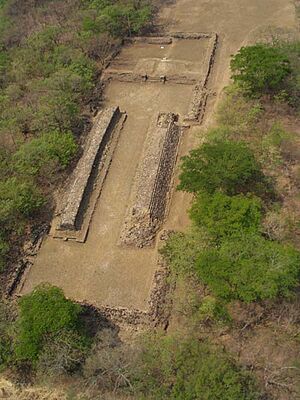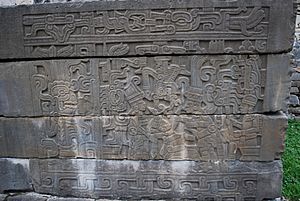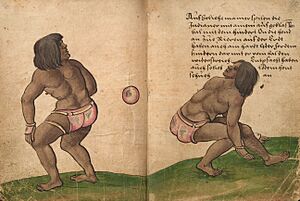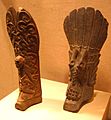Mesoamerican ballgame facts for kids
The Mesoamerican ballgame was an ancient sport played by people in Mesoamerica (parts of modern-day Mexico and Central America). It was more than just a game; it was also a very important ritual and religious event. People played this game for thousands of years, starting around 1650 BC. Today, a modern version called ulama is still played by some native groups.
We don't know the exact rules of the ancient game. But it was probably similar to racquetball, where players try to keep the ball moving. In most versions, players hit the ball with their hips. However, some versions allowed using forearms, rackets, bats, or special handstones. The ball was made of solid rubber and could be quite heavy, sometimes weighing up to 9 lbs (4 kg)! Its size changed depending on the time and place.
People played the Mesoamerican ballgame for fun, even children. But the big, formal games were important ceremonies. Many ancient ballcourts have been found across Mesoamerica. They usually have a long, narrow playing area with slanted or straight walls.
Contents
What Was the Mesoamerican Ballgame Called?
The Mesoamerican ballgame had many names. In English, it's often called pok-ta-pok or pok-a-tok. This name comes from a Maya word.
In Nahuatl, the language of the Aztecs, it was called ōllamaliztli or tlachtli. The Maya called it pitz. In modern Spanish, it's known as juego de pelota maya (Maya ballgame).
Where Did the Ballgame Come From?

No one knows exactly when or where the Mesoamerican ballgame started. It likely began before 2000 BC in the warm, wet areas where rubber trees grow.
One possible starting place is the Pacific coast lowlands in Mexico. The oldest ballcourt found so far is at a place called Paso de la Amada. It dates back to about 1400 BC.
Another possible origin is the Olmec heartland near the Gulf Coast of Mexico. The Aztecs called the people from this area Olmeca, meaning "rubber people." This is because the region was famous for making latex (rubber). The oldest known rubber balls in the world were found at El Manatí, an early Olmec site. These balls are from around 1700–1600 BC. They were found with other special items, showing the game had religious meaning even then.
The game then spread from these tropical areas to central Mexico. By 300 BC, we find evidence of the game all over Mesoamerica. This includes ballcourts in places like the Central Chiapas Valley and the Oaxaca Valley.
How Was the Game Played?
Since the game was played for such a long time by many different cultures, the details changed. So, it was more like a family of related games. The most common version involved hitting the ball with the hips. This was likely the main game played in the stone ballcourts.
However, there's also evidence of games where players used wooden sticks (like field hockey), racquets, bats, handstones, or even their forearms. Each type of game probably had its own ball size, special gear, and rules.
Games were played between two teams, usually with two to four players per team. Some games were casual and played on simple courts. Others were big, formal events held in huge stone ballcourts. The game could be rough, and players sometimes got serious injuries from the heavy rubber ball.
In the modern ulama game, it's a bit like volleyball without a net. Each team stays on its side of the court. Players hit the ball back and forth using only their hips until one team can't return it or the ball goes out of bounds.
Later, the Maya, Toltec, and Aztec cultures added vertical stone rings to the sides of the court. The goal was to pass the ball through one of these rings. This was very hard to do! For example, the rings at Chichen Itza were about 20 ft (6 m) high. Most games were probably won by points, not by getting the ball through a ring.
What Did Players Wear?
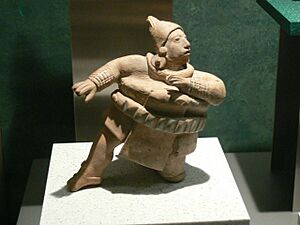
We don't have the actual clothing or gear from ancient times, except for stone items. So, we learn about what players wore from ancient art, like paintings, drawings, and stone carvings. Their outfits changed a lot over time and in different places.
For the hip-ball game, players usually wore a loincloth. Sometimes they added leather hip guards for protection. These basic outfits are seen in the oldest player figures and are still worn by modern ulama players today.
Many cultures also used a thick girdle, probably made of wicker or wood covered in fabric or leather. These girdles helped protect players and also gave more power when hitting the ball. Stone "yokes" have been found, which look like these girdles but are too heavy for actual play. They were likely used in rituals before or after the game. Some players also wore chest protectors called palmas.
Kneepads were common, often worn on just one knee. A type of garter was also seen, but its purpose is unknown. Gloves appear in some ancient art. Helmets were probably for protection, and fancy headdresses were likely for ritual events.
Rubber Balls
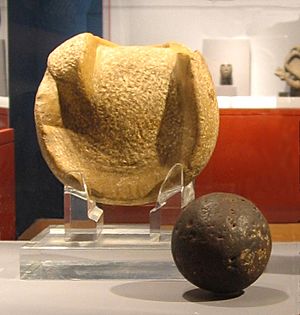
We don't know the exact sizes or weights of the balls used in the game. Many ancient balls have been found, but they were mostly offerings, not necessarily game balls.
Most researchers believe the ancient hip-balls were made from the sap of the Castilla elastica rubber tree. People discovered that mixing this sap with sap from a morning glory vine made the rubber bouncy and strong. These balls varied in size, usually between 10 in (25 cm) and 12 in (30 cm) across. They weighed between 3 lb (1.4 kg) and 6 lb (2.7 kg).
Some Maya pictures show balls that look very large, even 1 m (3.3 ft) wide. But experts think these are artistic exaggerations or symbols, like the huge headdresses also shown in the same pictures.
Ballcourts
The game was played in large stone buildings called ballcourts. Over 1,300 ballcourts have been found! They all have a similar shape: a long, narrow playing area with walls on both sides. These walls could be horizontal, sloping, or vertical. They were often plastered and painted in bright colors.
Early ballcourts were open at the ends. Later ones had enclosed end-zones, making them look like a capital "I" from above. Ballcourts varied greatly in size. The Great Ballcourt at Chichen Itza is the largest, measuring 316 ft (96.5 m) by 98 ft (30 m). Others, like the Ceremonial Court at Tikal, were much smaller.
Ballcourts were important public places. People used them for many events, including musical performances, festivals, and of course, the ballgame. Ancient art often shows musicians playing during ballgames.
Why Was the Ballgame So Important?
The Mesoamerican ballgame was deeply connected to the cultures of ancient Mesoamerica. It was much more than just a sport.
Solving Conflicts
Some historians believe the game was used to solve problems between groups or cities without going to war. Instead of fighting a battle, leaders would play a ballgame. The winner would then rule over the losers. This idea suggests the game helped keep peace and solve arguments within society.
This theory also explains why some places had many ballcourts, while others had few. Empires with strong central governments and few enemies, like the Aztec Empire, had fewer ballcourts. But places with many different cultures and weaker governments, like Cantona (which had 24 ballcourts!), used the game more often to settle disputes.
Many ballcourts also show images of warfare. For example, some carvings show ballplayers dressed as warriors. Captives are also often shown in ballgame art. Even the modern ulama game used to be linked to warfare.
Human Sacrifice
The idea of human sacrifice being linked to the ballgame appears later in history, during the Classic era. This connection was especially strong in the Classic Veracruz and Maya cultures.
Symbolic Meanings
The ballgame had many symbolic meanings. Here are some common ideas:
- Astronomy: The bouncing ball might have represented the sun. The stone rings could have symbolized sunrise, sunset, or special times of the year.
- War: This is a clear meaning. The ball could represent a defeated enemy.
- Fertility: Some early ballplayer figures show symbols of maize (corn). At a site called El Tajín, the sacrifice of a ballplayer was linked to renewing pulque, an alcoholic drink.
- Cosmic Duality: The game was seen as a struggle between day and night, or between life and the underworld. Ballcourts were sometimes thought of as gateways to the underworld. Playing the game helped keep the universe in order and bring new life.
Maya Beliefs

The famous Maya Twin myth from the Popol Vuh shows how important the game was. It connects the game to warfare, fertility, and death. Ballcourts were seen as places where life and death met. Special markers on the ballcourts often showed mythical scenes and were thought to be portals to another world.
The Ballgame in Different Civilizations
Maya Civilization

For the Maya, the Hero Twins myth linked ballcourts with death and overcoming it. The ballcourt was a place of change, a step between life and death. Ballcourt markers showed ritual and mythical scenes, often with a special shape that looked like a portal to another world.
Teotihuacan
No ballcourt has been found at Teotihuacan, which is surprising because it was a very large city. The ballgame seems to have been less popular there, and in areas influenced by Teotihuacan.
However, murals (wall paintings) at Teotihuacan show different types of ballgames. Some show a two-player game in a stone court. Others show teams using sticks on an open field. It's thought that a stick-game might have been more popular than the hip-ball game in Teotihuacan. After Teotihuacan fell, the hip-ball game became popular again.
Aztec
The Aztec version of the ballgame was called ōllamalitzli. The ball was called ōllamaloni, and the court was a tlachtli. In the Aztec capital, Tenochtitlan, the biggest ballcourt was called Teotlachco (meaning "in the holy ballcourt"). Important rituals took place here, including the sacrifice of war captives.
For the Aztecs, the ballgame also had religious meaning. They might have seen it as a battle between the sun god Huitzilopochtli and the forces of night. But it was also a sport and a pastime played for fun, mostly by nobles.
Young Aztecs learned ballplaying in school. The best players could even become famous professionals. Games were often held in city areas and markets, with lots of betting. Some people even bet their children or themselves and became slaves if they lost!
Since rubber trees didn't grow in the Aztec Empire's highlands, the Aztecs got rubber as a payment from lowland areas. A historical book called the Codex Mendoza says that 16,000 lumps of raw rubber were sent to Tenochtitlan every six months.
In 1528, after the Spanish conquest, Hernán Cortés sent Aztec ballplayers to Spain to perform for Charles V. Europeans were amazed by the bouncing rubber balls, which they had never seen before.
Pacific Coast
Ballcourts and ballgame items have been found along the Pacific coast of Guatemala and El Salvador. This includes sites like Bilbao and El Baúl.
Caribbean
The game of Batey, played on many Caribbean islands, might be a descendant of the Mesoamerican ballgame, possibly through the Maya.
Images for kids
-
The ballcourt at Tikal, in the Maya lowlands.
-
Ruins at Wupatki National Monument, Arizona. Experts disagree if these structures were used for ballgames, but most think they were. There's also debate about how much any Southwest ballgame is related to the Mesoamerican ballgame.
See also
 In Spanish: Juego de pelota mesoamericano para niños
In Spanish: Juego de pelota mesoamericano para niños


